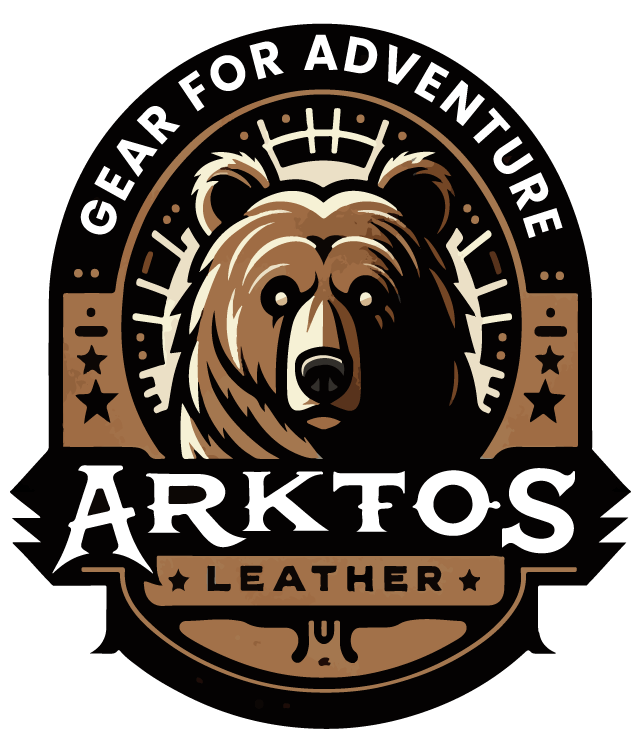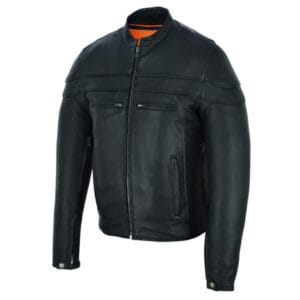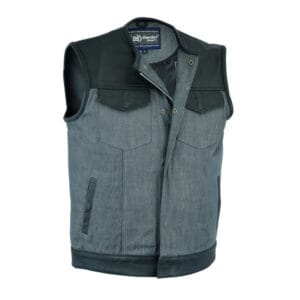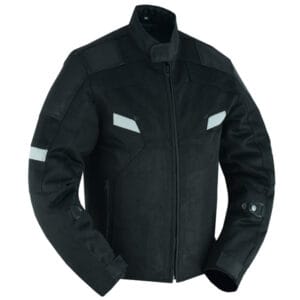The roar of engines and the open road call to more than just commuters – they beckon to a community of adventurers and passionate enthusiasts. At the heart of motorcycle culture lies an enduring icon: leather. Far beyond mere fashion, leather gear – from jackets to gloves and pants – carries a mystique that has defined riders for generations. This exploration uncovers the allure of leather in motorcycling, tracing its historical roots, practical advantages, and lasting impact on biker culture.
The Dawn of Protective Gear
In motorcycling’s early days, riders lacked specialized attire, often braving the elements in everyday clothes. This inadequacy quickly revealed the need for robust protection against road hazards and harsh weather. Riders soon discovered that their regular clothing offered little defense against the unique challenges of motorcycling, prompting a search for more suitable alternatives.
Men’s Natural Soft Leather Vented Motorcycle Jacket W/ Thermal Liner
The Rise of Leather in Motorcycling
As the two-wheeled revolution gained momentum, manufacturers recognized leather’s potential. The 1920s and 1930s saw the emergence of purpose-built leather jackets, setting a new standard in rider safety. By mid-century, leather had solidified its position as the premier material for motorcycle gear, offering unparalleled protection and style. Its natural properties made it ideal for withstanding the rigors of the road, providing a level of safety that other materials of the time couldn’t match.
Leather’s Dominance in Biker Culture
Beyond its practical attributes, leather became synonymous with the rebellious spirit of motorcycling. Its rugged aesthetic, popularized by media, embodied the freedom of the open road. From classic jackets to sturdy boots, leather gear became an integral part of the biker identity. This cultural significance reinforced leather’s importance, making it not just a safety choice but a statement of belonging within the motorcycling community.
Mens Premium Leather Short Cruiser Gloves
The Functionality of Leather
Unmatched Durability and Longevity Leather’s exceptional resilience makes it the ideal choice for riders seeking long-lasting protection. Its ability to withstand years of use without compromising integrity ensures consistent safety throughout a rider’s journey. Unlike synthetic materials that may degrade over time, high-quality leather often improves with age, maintaining its protective qualities even after extensive use.
Superior Abrasion Resistance
In the event of a fall, leather’s remarkable abrasion resistance becomes a lifesaver. Its natural grain creates a formidable barrier against road friction, significantly reducing the risk of severe injuries during slides. This property is crucial in protecting riders from road rash and other abrasion-related injuries that can occur during accidents. The density and strength of leather fibers allow it to withstand the intense friction of a slide, providing crucial seconds of protection that can mean the difference between minor and severe injuries.
Comprehensive Weather Protection
Leather’s dense structure provides excellent defense against various weather conditions. Its wind-resistant properties and natural water repellency offer riders comfort and protection in diverse environments, making it a versatile choice for year-round riding. While not completely waterproof without treatment, leather’s natural properties help keep riders dry in light rain and protect against wind chill, a critical factor in maintaining body temperature during long rides.
Safety Considerations
Enhanced Impact Protection While renowned for abrasion resistance, leather gear often incorporates additional padding in crucial areas. This combination of leather’s inherent toughness and strategically placed armor maximizes protection against impacts, reducing the risk of serious injuries. Modern leather gear frequently includes CE-certified armor in areas like shoulders, elbows, and knees, providing comprehensive protection against both abrasion and impact.
Women’s Lightweight Leather Two Tone Motorcycle Hip Set Chaps
Leather vs. Alternative Materials
When compared to textiles and synthetic options, leather consistently proves its worth in safety. While other materials may offer benefits like lightness or increased breathability, they often fall short of leather’s protective qualities and longevity. Textile gear, while improving, typically doesn’t match leather’s abrasion resistance, especially in high-impact scenarios. Synthetic leather, while more affordable, generally lacks the durability and protective qualities of genuine leather.
Adherence to Safety Standards
High-quality leather gear frequently meets or exceeds rigorous safety certifications. These standards ensure that leather protective wear provides the necessary safeguards for riders, reinforcing its status as a top choice for motorcycle safety. Many leather products are CE-certified, meeting European standards for protective motorcycle clothing. This certification process involves testing for abrasion resistance, impact protection, and overall structural integrity, ensuring that leather gear provides reliable protection in real-world scenarios.
Alternatives to Leather
Textiles: A Different Approach While textiles offer advantages in weight and ventilation, they struggle to match leather’s protective capabilities. The trade-off between comfort and safety often tilts in leather’s favor for serious riders. Modern textiles, including materials like denim vests, Cordura and Kevlar-reinforced fabrics, have improved but still generally fall short of leather in terms of abrasion resistance and longevity. However, textiles do offer benefits in terms of weather versatility and ease of maintenance.
Mesh and Ventilated Options: Despite their cooling properties, mesh and ventilated gear compromise on the crucial aspect of abrasion resistance. In high-risk scenarios, these alternatives may not provide the comprehensive protection that leather gear offers. While mesh gear is popular in hot climates, its open structure inherently reduces its protective qualities. Riders opting for mesh must carefully weigh the benefits of increased airflow against the reduced safety in case of an accident.
Advanced Materials in the Mix: Materials like Kevlar show promise but often come at a premium without fully replicating leather’s all-around protective qualities. Leather remains the benchmark against which these innovations are measured. While Kevlar and similar materials offer excellent tear and abrasion resistance, they often need to be combined with other fabrics to create a wearable garment such as armored flannels, which can affect their overall protective capabilities.
Men’s Perforated Leather/Denim Combo Biker Vest Ash Gray
Comfort and Ergonomics
The Perfect Fit of Leather
Leather’s ability to mold to the rider’s body creates a second-skin effect, ensuring that protective elements stay in place. This personalized fit enhances both comfort and safety during long rides. Over time, leather gear adapts to the rider’s body shape and movements, providing a level of comfort and protection that off-the-rack textile gear struggles to match. This custom fit is crucial for maintaining the correct position of protective padding and ensuring freedom of movement.
Climate Control Capabilities
While not as naturally breathable as some materials, modern leather gear often incorporates ventilation features. This adaptation allows leather to maintain its protective edge while improving comfort in various weather conditions. Perforated leather and strategically placed vents help manage temperature, making leather gear more versatile across different climates. Additionally, leather’s natural properties help it retain warmth in cooler weather, providing a broader range of temperature comfort compared to many synthetic materials.
Freedom of Movement
High-quality leather strikes an ideal balance between protection and flexibility. Its natural properties allow for a full range of motion, crucial for maintaining control of the motorcycle without compromising safety. Well-designed leather gear includes pre-curved sleeves and articulated joints, ensuring that the protective qualities of the leather don’t come at the cost of rider mobility. This flexibility is essential for both comfort during long rides and quick reactions in emergency situations.
Men’s SOA Leather Biker Vest W/ USA Flag Lining
Style and Perception
The Timeless Appeal of Leather
Leather’s iconic status in motorcycling goes beyond aesthetics. Its enduring popularity stems from the perfect blend of style and substance, offering riders both protection and a connection to motorcycling heritage. The classic look of a leather motorcycle jacket has transcended the riding community to become a fashion statement in its own right, further cementing leather’s place in motorcycle culture.
Cultural Significance in the Riding Community
Motorcycle Leather gear represents more than just clothing; it’s a symbol of belonging within the motorcycling subculture. Its adoption signifies a commitment to both safety and the shared values of the riding community. Leather jackets, in particular, often become canvases for personal expression through patches, pins, and customization, allowing riders to display their affiliations and experiences.
Navigating Public Perceptions
While stereotypes about leather-clad riders persist, many recognize the practical safety benefits of leather gear. Educated riders choose leather not just for its image, but primarily for its unparalleled protective qualities. The perception of leather-wearing motorcyclists has evolved over time, with many now associating it with responsible riding and a serious approach to safety rather than rebelliousness.
Black High-Viz Performance Mesh Biker Jacket
Legal Requirements
Global Regulatory Landscape Motorcycle gear regulations vary worldwide, but leather often meets or exceeds legal requirements. Its protective properties align well with safety standards in many regions, making it a reliable choice for compliance. In countries with strict gear laws, leather products are frequently among the first to meet new safety standards, ensuring that riders can stay both legal and well-protected.
Essential Protective Gear
While motorcycle helmet laws are nearly universal, regulations on other protective gear vary. Leather’s proven safety record makes it a smart choice for riders looking to meet and surpass legal requirements for protective clothing. In some regions, leather or equivalently protective materials are mandated for jackets and pants, recognizing the crucial role these items play in rider safety.
D.O.T German Motorcycle Helmet – Dull Black
Consequences of Non-Compliance
Failing to wear adequate protective gear can result in legal penalties and increased risk. Leather’s comprehensive protection helps riders stay on the right side of the law while maximizing their safety on the road. In the event of an accident, wearing appropriate leather gear can also have legal implications, potentially affecting insurance claims and liability assessments.
Conclusion
Leather’s vital role in biker protection is undeniable. Its superior abrasion resistance, impact protection, and durability make it an unparalleled choice for motorcycle gear. While alternatives exist, leather continues to set the standard for rider safety, combining functional protection with cultural significance. From its historical roots to its modern adaptations, leather remains an essential element in ensuring the well-being of motorcyclists on the open road.
The evolution of leather in motorcycling reflects a continuous commitment to rider safety. As motorcycle technology advances, so too does the design and functionality of motorcycle leather gear. Modern leather products incorporate the latest safety innovations while maintaining the material’s inherent protective qualities. This blend of tradition and technology ensures that leather remains at the forefront of motorcycle safety gear.
Moreover, the environmental impact of leather production is increasingly being addressed, with sustainable practices and ethical sourcing becoming more prevalent. This shift allows riders to choose motorcycle leather gear that aligns with both safety priorities and environmental consciousness.
Ultimately, the choice of motorcycle gear is a personal one, influenced by factors including riding style, climate, and personal preferences. However, the enduring popularity and proven protective qualities of leather make it a compelling choice for riders who prioritize safety. As long as motorcycles roam the roads, leather will likely continue to play a crucial role in protecting those who choose the two-wheeled lifestyle.






